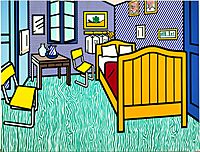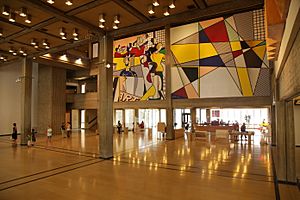Roy Lichtenstein facts for kids
Quick facts for kids
Roy Lichtenstein
|
|
|---|---|
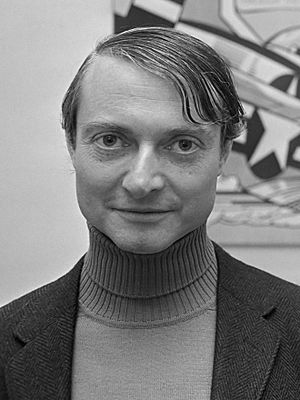
Lichtenstein in 1967
|
|
| Born |
Roy Fox Lichtenstein
October 27, 1923 New York City, U.S.
|
| Died | September 29, 1997 (aged 73) New York City, U.S.
|
| Education | Timothy Dwight School, Parsons School of Design |
| Alma mater | Ohio State University |
| Known for | Painting, sculpture |
| Movement | Pop art |
| Spouse(s) |
|
| Patron(s) | Gunter Sachs |
Roy Fox Lichtenstein (October 27, 1923 – September 29, 1997) was an American pop artist. He became a very important artist in the 1960s. He was known for his unique style, which often looked like comic strips.
Lichtenstein's art used bright colors and bold outlines. He also used a printing technique called Ben-Day dots. His most famous works include Whaam! and Drowning Girl. These paintings are seen as very important examples of pop art. His painting Masterpiece sold for $165 million in 2017.
Contents
Early Life and Art Interests
Roy Lichtenstein was born in New York City in 1923. His father, Milton, was a real estate agent. His mother, Beatrice, stayed at home. Roy grew up on the New York City's Upper West Side.
He went to public school until he was twelve. Then he attended New York's Dwight School. Roy first became interested in art as a hobby through school. He loved jazz music and often drew pictures of musicians. In 1939, he took summer art classes.
Starting His Art Career
After high school, Lichtenstein went to Ohio State University. There he studied fine arts. His studies were paused for three years when he served in the Army during World War II. He returned to Ohio State after the war. He earned his Master of Fine Arts degree in 1949.
In 1951, Lichtenstein had his first art show in New York. He moved to Cleveland and lived there for six years. During this time, he worked different jobs while still painting. His art style changed between Cubism and Expressionism. He had two sons, David and Mitchell Lichtenstein.
In 1957, he moved back to New York and started teaching art again. He began to include hidden cartoon characters in his art.
Becoming a Famous Pop Artist
In 1960, Lichtenstein taught at Rutgers University. This helped him get interested in pop art ideas. In 1961, he started making his first pop paintings. These used cartoon images and commercial printing styles.
One of his first big pop art pieces was Look Mickey (1961). He used large, clear figures and Ben-Day dots in this work. The idea for this painting came from his son. His son pointed to a Mickey Mouse comic book and challenged him to paint as well as the comic artist.
In 1961, an art dealer named Leo Castelli started showing Lichtenstein's work. Lichtenstein had his first solo show at Castelli's gallery in 1962. All the paintings were bought before the show even opened! This made him very well-known.
His art was inspired by war and romance comics. He liked subjects that were "emotionally strong." He wanted his careful painting style to be different from the strong emotions in the comics.
His Most Famous Works
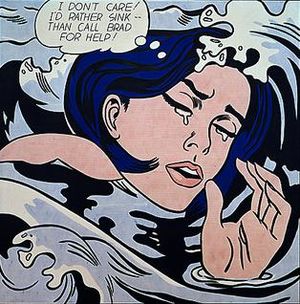
Lichtenstein became famous around the world. He moved back to New York City to be in the center of the art world. He stopped teaching in 1964 to focus on painting full-time.
He used oil and Magna (an early acrylic paint) in his most famous works. One example is Drowning Girl (1963). This painting was based on a DC Comics story. Drowning Girl uses thick outlines, bold colors, and Ben-Day dots. It looks like a picture from a comic book.
Lichtenstein said his style was different from other artists. He didn't use thick or thin brushstrokes like some. Instead, he used dots and flat colors. He wanted to show how mass media (like comics) presented things.
When his art was first shown, some critics didn't like it. They said it wasn't original. A magazine even asked, "Is He the Worst Artist in the U.S.?" Lichtenstein said his work was "entirely transformed" even though it looked like copies. He said his purpose was different.
His most famous painting is Whaam! (1963). It is one of the earliest examples of pop art. It was inspired by a comic-book panel from a 1962 DC Comics issue. The painting shows a fighter jet shooting a rocket. It has the word "Whaam!" and a caption like a comic. This painting is very large. It is now at the Tate Modern in London.
Lichtenstein also started making sculptures around 1964. He made heads out of clay and then added his signature black lines and Ben-Day dots. This made the 3D objects look flat, like his paintings.
He mostly stopped using comic book panels directly in 1965. However, he sometimes used them in different ways later. Some people criticized him for not giving credit to the original comic artists. Lichtenstein said he was "restating the copied thing in other terms." He felt his changes made it new art.
Later Art and Commissions
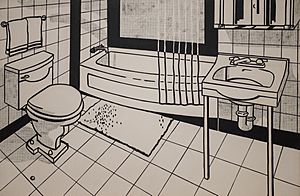
In the mid-1960s, Lichtenstein began his Modern Paintings series. He used his dots and lines to create images from architecture and Art Deco designs. He also made Modern Sculpture inspired by Art Deco.
Lichtenstein also made his own versions of famous paintings by other artists. For example, he created Bedroom at Arles (1992) based on Vincent van Gogh's famous painting.
In the 1970s, his style became a bit looser. He explored new themes like Mirrors and Entablatures. He also created "Artists Studios" paintings. These works included parts of his earlier art within a studio scene.
He was interested in Expressionism and Surrealism in the late 1970s. He made works that looked like German Expressionist art. He also created surreal pieces, some based on Native American themes.
Lichtenstein made many Still Life paintings and sculptures. These included traditional subjects like fruit and flowers. He also created over 300 prints, mostly using screenprinting.
Art for Public Places
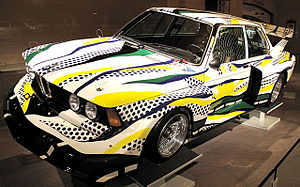
Lichtenstein received many important jobs to create art for public places.
- In 1978, he made the sculpture Lamp in Georgia.
- In 1979, he created Mermaid in Miami Beach.
- He painted a five-story high mural called Mural with Blue Brushstroke (1984–85) in New York.
- In 1992, he created El Cap de Barcelona in Barcelona, Spain.
- In 1994, he made the Times Square Mural for the Times Square subway station in New York.
In 1977, BMW asked him to paint a racing car for their BMW Art Car Project. His last finished project was the logo for DreamWorks Records.
Awards and Recognition
Roy Lichtenstein received many awards for his art:
- 1977 Skowhegan Medal for Painting.
- 1979 Member of the American Academy of Arts and Letters.
- 1995 Kyoto Prize in Arts and Philosophy.
- 1995 National Medal of the Arts.
He also received several honorary degrees from universities. In 2023, five of his paintings were featured on USPS Forever stamps.
Personal Life
In 1949, Lichtenstein married Isabel Wilson. They had two sons, David and Mitchell. The couple divorced in 1965.
In 1968, Lichtenstein married his second wife, Dorothy Herzka. From 1970 until his death, he divided his time between Manhattan and Southampton, New York.
Roy Lichtenstein passed away from pneumonia on September 29, 1997. He was almost 74 years old. He was survived by his wife, Dorothy, and his two sons.
His Art's Impact
Pop art continues to be important today. Roy Lichtenstein and Andy Warhol are two of the most famous pop artists. They explored how fine art, advertising, and consumerism are connected.
Lichtenstein's work Crying Girl was featured in the movie Night at the Museum: Battle of the Smithsonian.
Exhibitions and Collections
Lichtenstein's art has been shown in many museums around the world.
- In 1964, he was the first American to have his art shown at the Tate Gallery in London.
- His first museum show was in California in 1967.
- The Solomon R. Guggenheim Museum held a big show of his work in 1969.
- In 1987, he was the first living artist to have a solo drawing exhibition at the Museum of Modern Art.
The National Gallery of Art in Washington, D.C., has the largest collection of his prints. The Art Institute of Chicago also has important works by him. Many of his works are also in the Museum Ludwig in Germany.
Roy Lichtenstein Foundation
After Lichtenstein's death, the Roy Lichtenstein Foundation was created in 1999. This foundation helps to study and share his art.
In 2006, a painting called Electric Cord (1961) was missing. The foundation asked the public for help finding it. In 2012, the painting was found in a New York warehouse. The foundation confirmed it was a real Lichtenstein painting.
Art Market Success
Lichtenstein's paintings have sold for very high prices.
- In 1989, Torpedo ... Los! (1963) sold for $5.5 million.
- In 2010, Ohhh...Alright... (1964) sold for $42.6 million.
- In 2011, I Can See the Whole Room...and There's Nobody in It! (1961) sold for $43 million.
- In 2012, Sleeping Girl (1964) sold for $44.8 million.
- In 2013, Woman with Flowered Hat sold for $56.1 million.
- In 2015, Nurse sold for $95.4 million.
- In 2017, Masterpiece sold for $165 million. This is his most expensive work sold at auction.
See also
 In Spanish: Roy Lichtenstein para niños
In Spanish: Roy Lichtenstein para niños




